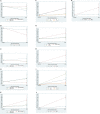Characterisation of medical conditions of children with sickle cell disease in the USA: findings from the 2007-2018 National Health Interview Survey (NHIS)
- PMID: 36854589
- PMCID: PMC9980332
- DOI: 10.1136/bmjopen-2022-069075
Characterisation of medical conditions of children with sickle cell disease in the USA: findings from the 2007-2018 National Health Interview Survey (NHIS)
Abstract
Objectives: We used the National Health Interview Survey (NHIS) data set to examine the prevalence of comorbid medical conditions; explore barriers to accessing healthcare and special educational services; and assess the associations between sickle cell disease (SCD) status and demographics/socioeconomic status (SES), and social determinants of health (SDoH) on comorbidities among children in the USA.
Design: Cross-sectional.
Setting: NHIS Sample Child Core questionnaire 2007-2018 data set.
Participants: 133 481 children; presence of SCD was determined by an affirmative response from the adult or guardian of the child.
Main outcome measures: Multivariate logistic regression was used to compare the associations between SCD status, SES and SDoH for various medical conditions for all races and separately for black children at p<0.05.
Results: 133 481 children (mean age 8.5 years, SD: 0.02), 215 had SCD and ~82% (weighted) of the children with SCD are black. Children with SCD were more likely to suffer from comorbid conditions, that is, anaemia (adjusted OR: 27.1, p<0.001). Furthermore, children with SCD had at least two or more emergency room (ER) visits (p<0.001) and were more likely to have seen a doctor 1-15 times per year (p<0.05) compared with children without SCD. Household income (p<0.001) and maternal education were lower for children with SCD compared with children without SCD (52.4% vs 63.5% (p<0.05)). SCD children with a maternal parent who has < / > High School degree were less likely to have no ER visits or 4-5 ER visits, and more likely to have 2-3 ER visits within 12 months.
Conclusion: Children with SCD experienced significant comorbid conditions and have high healthcare usage, with black children being disproportionately affected. Moreover, maternal education status and poverty level illustrates how impactful SES can be on healthcare seeking behaviour for the SCD population. SDoH have significant implications for managing paediatric patients with SCD in clinical settings.
Keywords: anaemia; community child health; public health.
© Author(s) (or their employer(s)) 2023. Re-use permitted under CC BY-NC. No commercial re-use. See rights and permissions. Published by BMJ.
Conflict of interest statement
Competing interests: None declared.
Figures





Similar articles
-
Analysis of the 2007-2018 National Health Interview Survey (NHIS): Examining Neurological Complications among Children with Sickle Cell Disease in the United States.Int J Environ Res Public Health. 2023 Jun 15;20(12):6137. doi: 10.3390/ijerph20126137. Int J Environ Res Public Health. 2023. PMID: 37372724 Free PMC article.
-
Health status and healthcare use in a national sample of children with sickle cell disease.Am J Prev Med. 2010 Apr;38(4 Suppl):S528-35. doi: 10.1016/j.amepre.2010.01.003. Am J Prev Med. 2010. PMID: 20331954
-
Prevalence of Substance Use Disorders in Sickle Cell Disease Compared to Other Chronic Conditions: a Population-Based Study of Black American Adults.J Gen Intern Med. 2023 Apr;38(5):1214-1223. doi: 10.1007/s11606-022-07786-w. Epub 2022 Oct 11. J Gen Intern Med. 2023. PMID: 36220945 Free PMC article.
-
Impact of Race, Socioeconomic Status, and Geography on Healthcare Outcomes for Children With Sickle Cell Disease in the United States: A Scoping Review.Cureus. 2024 Mar 13;16(3):e56089. doi: 10.7759/cureus.56089. eCollection 2024 Mar. Cureus. 2024. PMID: 38618364 Free PMC article.
-
Sickle cell disease and social determinants of health: A scoping review.Pediatr Blood Cancer. 2023 Feb;70(2):e30089. doi: 10.1002/pbc.30089. Epub 2022 Dec 10. Pediatr Blood Cancer. 2023. PMID: 36495544 Free PMC article.
Cited by
-
Redefining High Emergency Department Utilization for Sickle Cell Disease.JAMA Netw Open. 2025 Jun 2;8(6):e2513361. doi: 10.1001/jamanetworkopen.2025.13361. JAMA Netw Open. 2025. PMID: 40455443 Free PMC article.
-
Inpatient Management of Pain Episodes in Children with Sickle Cell Disease: A Review.Children (Basel). 2024 Sep 10;11(9):1106. doi: 10.3390/children11091106. Children (Basel). 2024. PMID: 39334638 Free PMC article. Review.
-
Examining Individuals' Use of the Internet for Health Care Activities Over Time: Results from the US National Health Interview Survey.JMIR Hum Factors. 2025 Feb 26;12:e58362. doi: 10.2196/58362. JMIR Hum Factors. 2025. PMID: 40009837 Free PMC article.
-
Analysis of the 2007-2018 National Health Interview Survey (NHIS): Examining Neurological Complications among Children with Sickle Cell Disease in the United States.Int J Environ Res Public Health. 2023 Jun 15;20(12):6137. doi: 10.3390/ijerph20126137. Int J Environ Res Public Health. 2023. PMID: 37372724 Free PMC article.
References
Publication types
MeSH terms
Grants and funding
LinkOut - more resources
Full Text Sources
Medical
